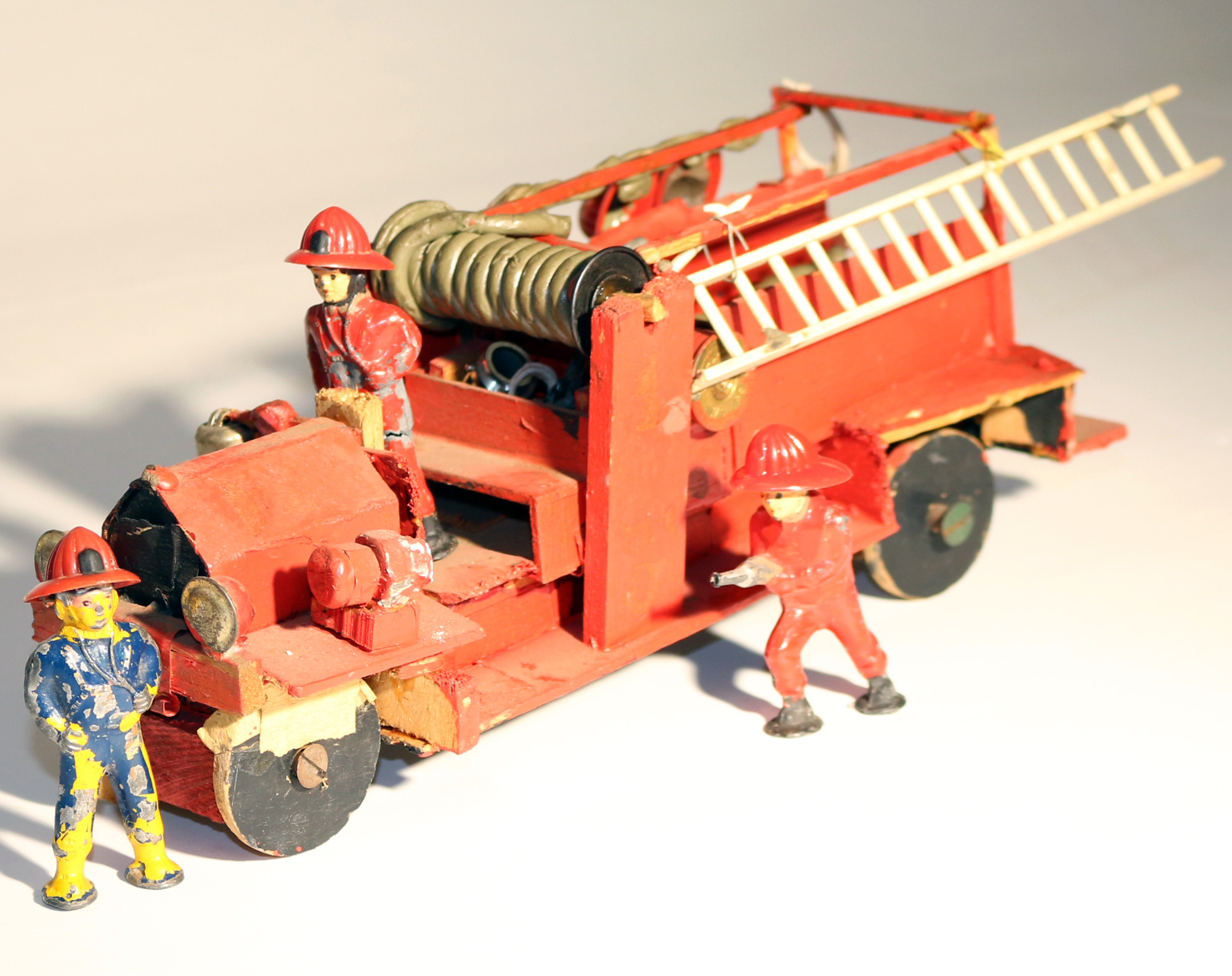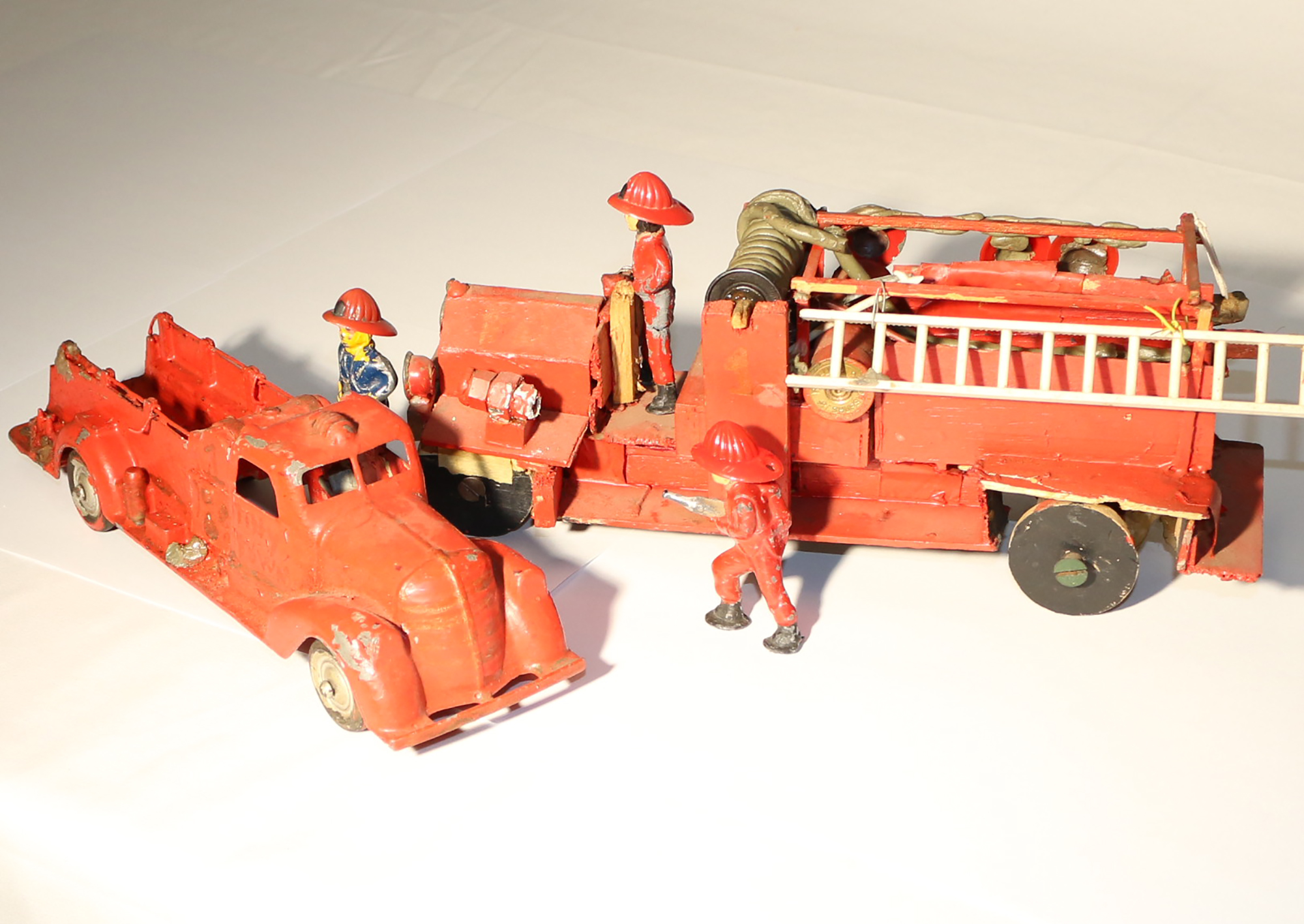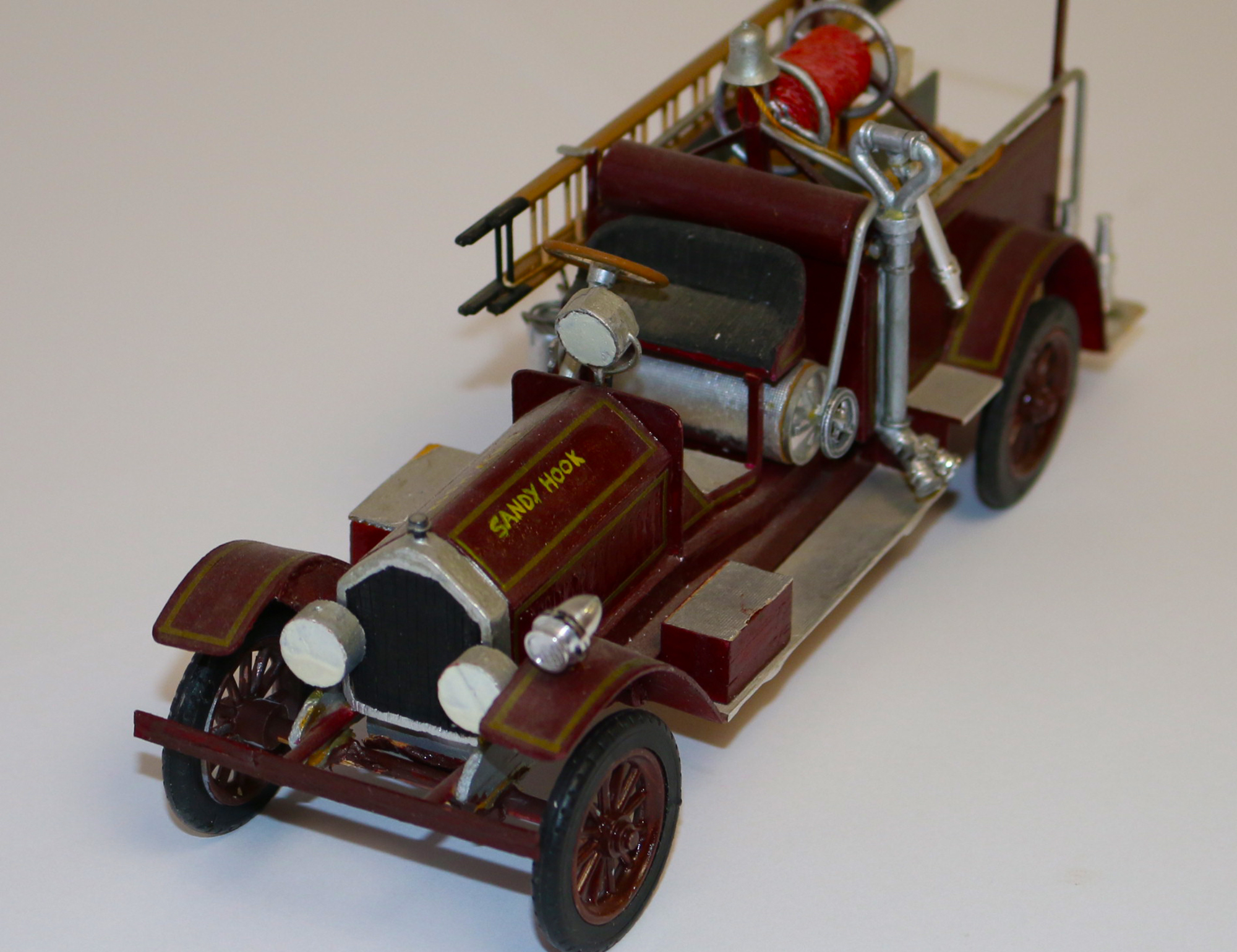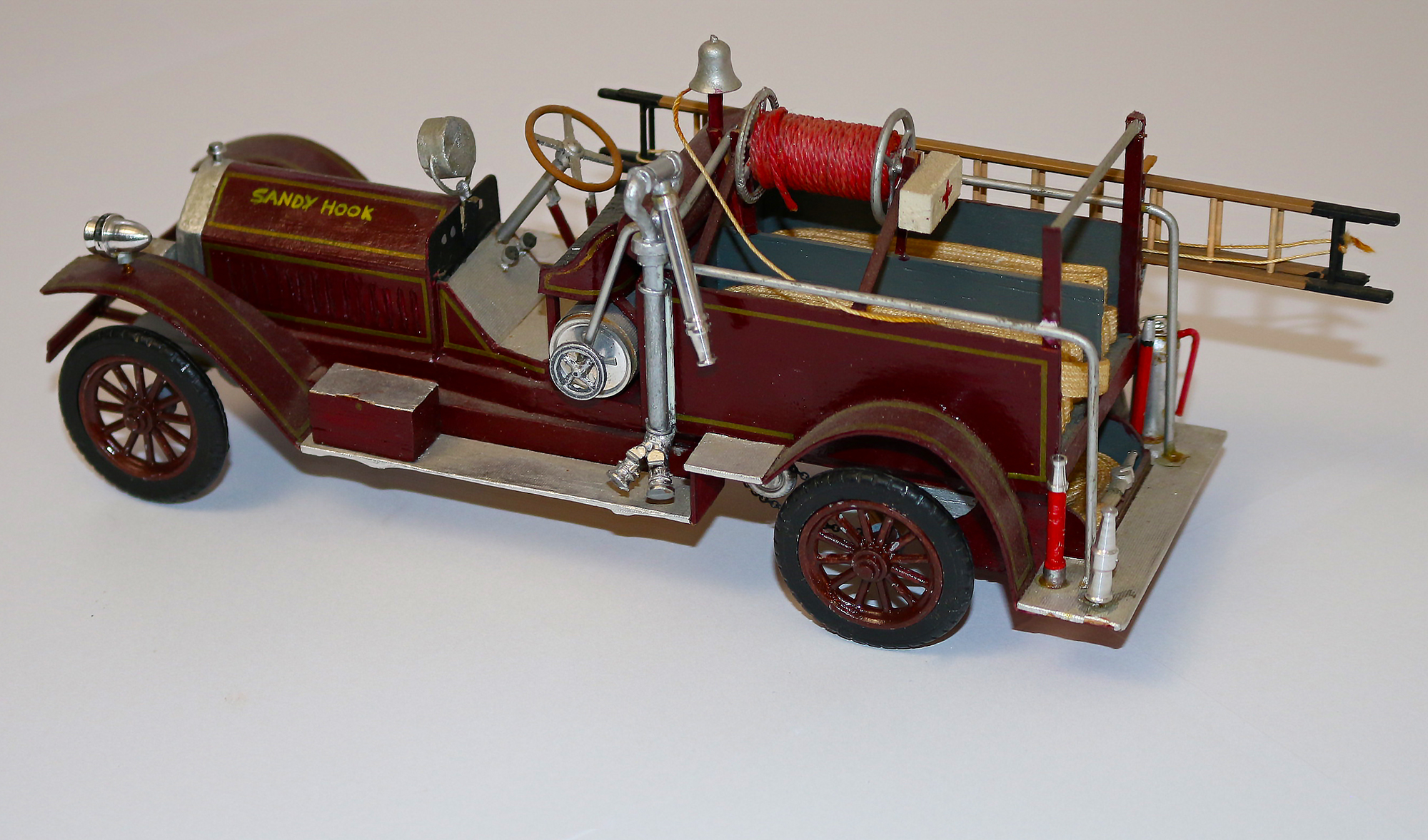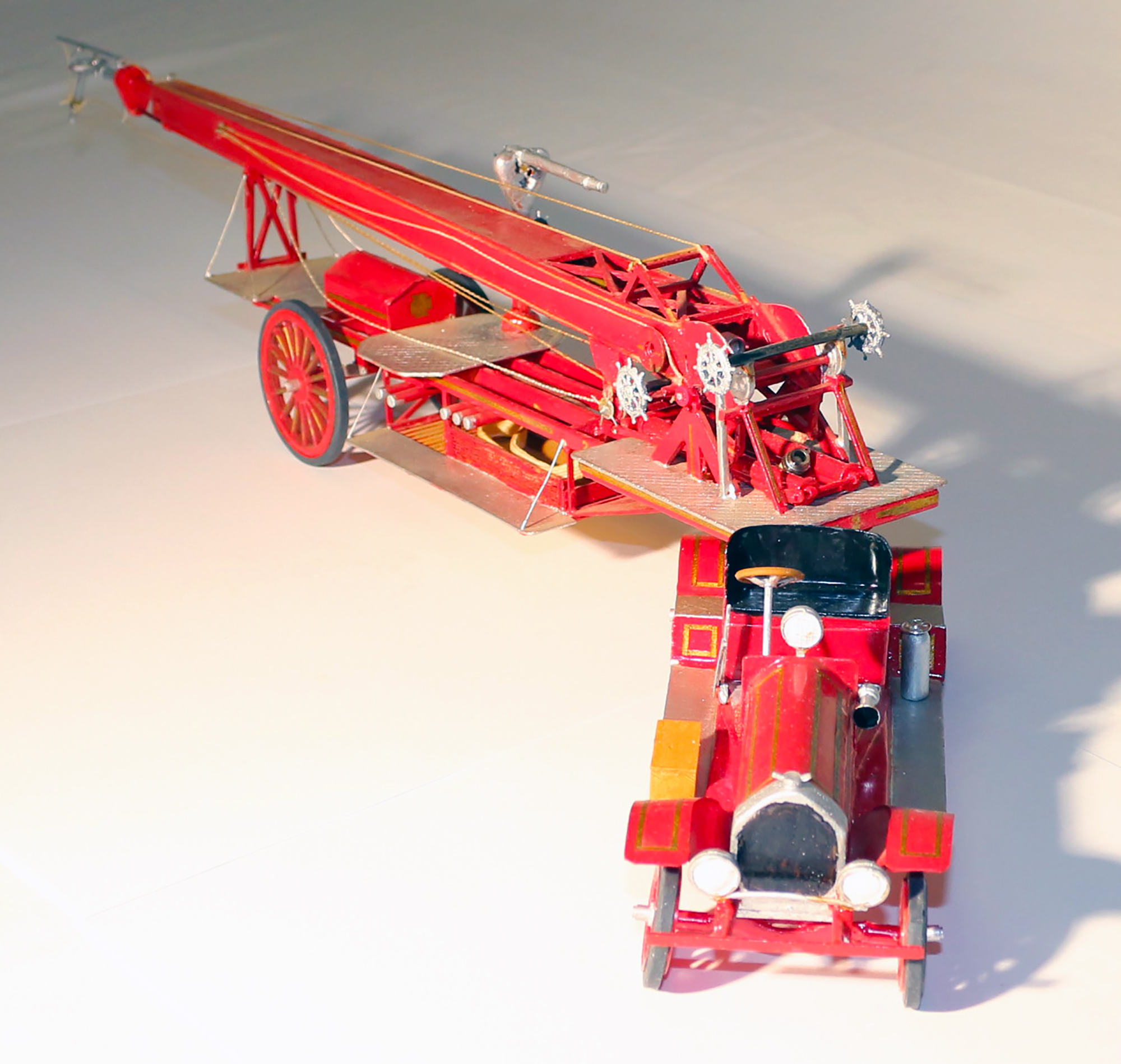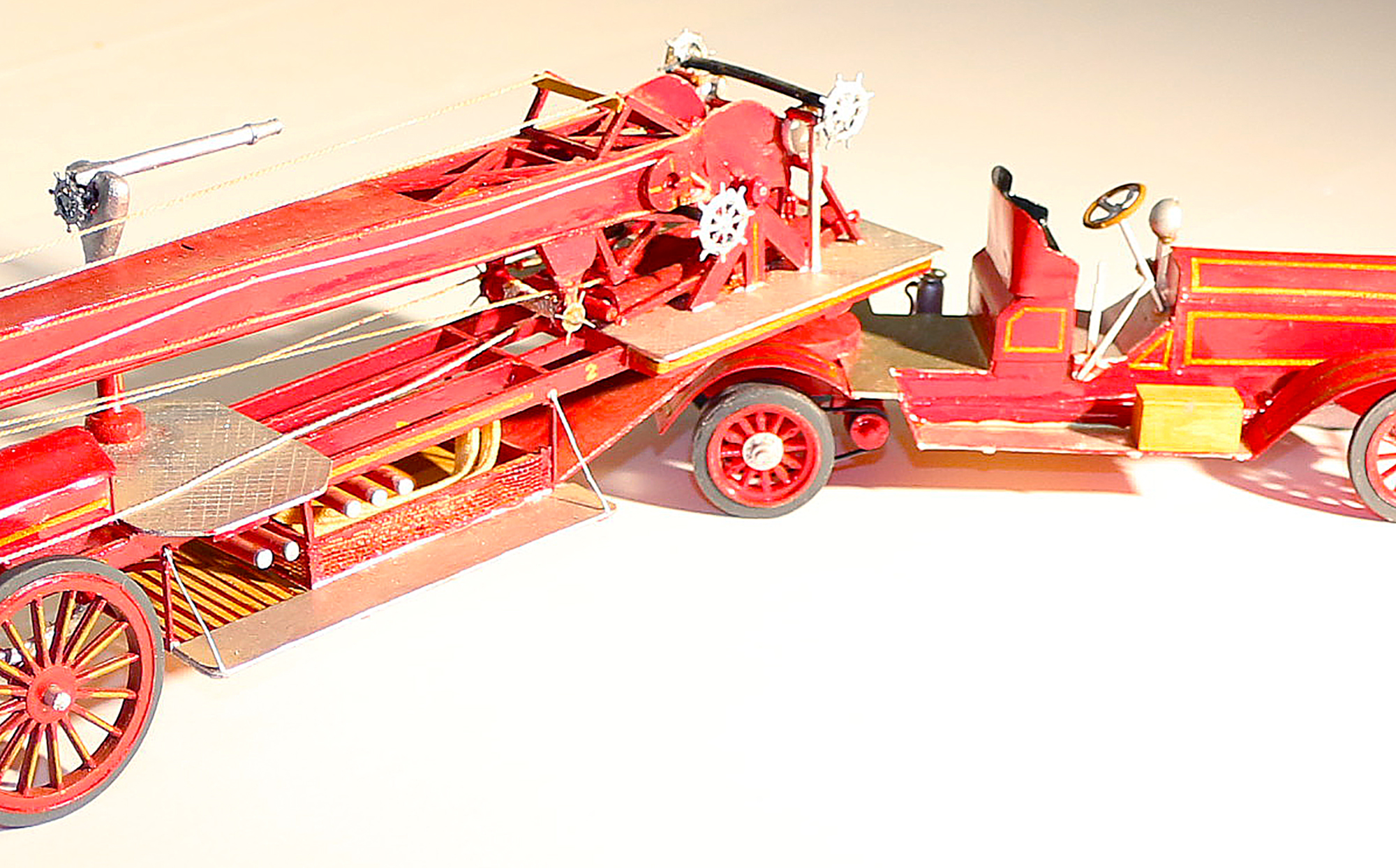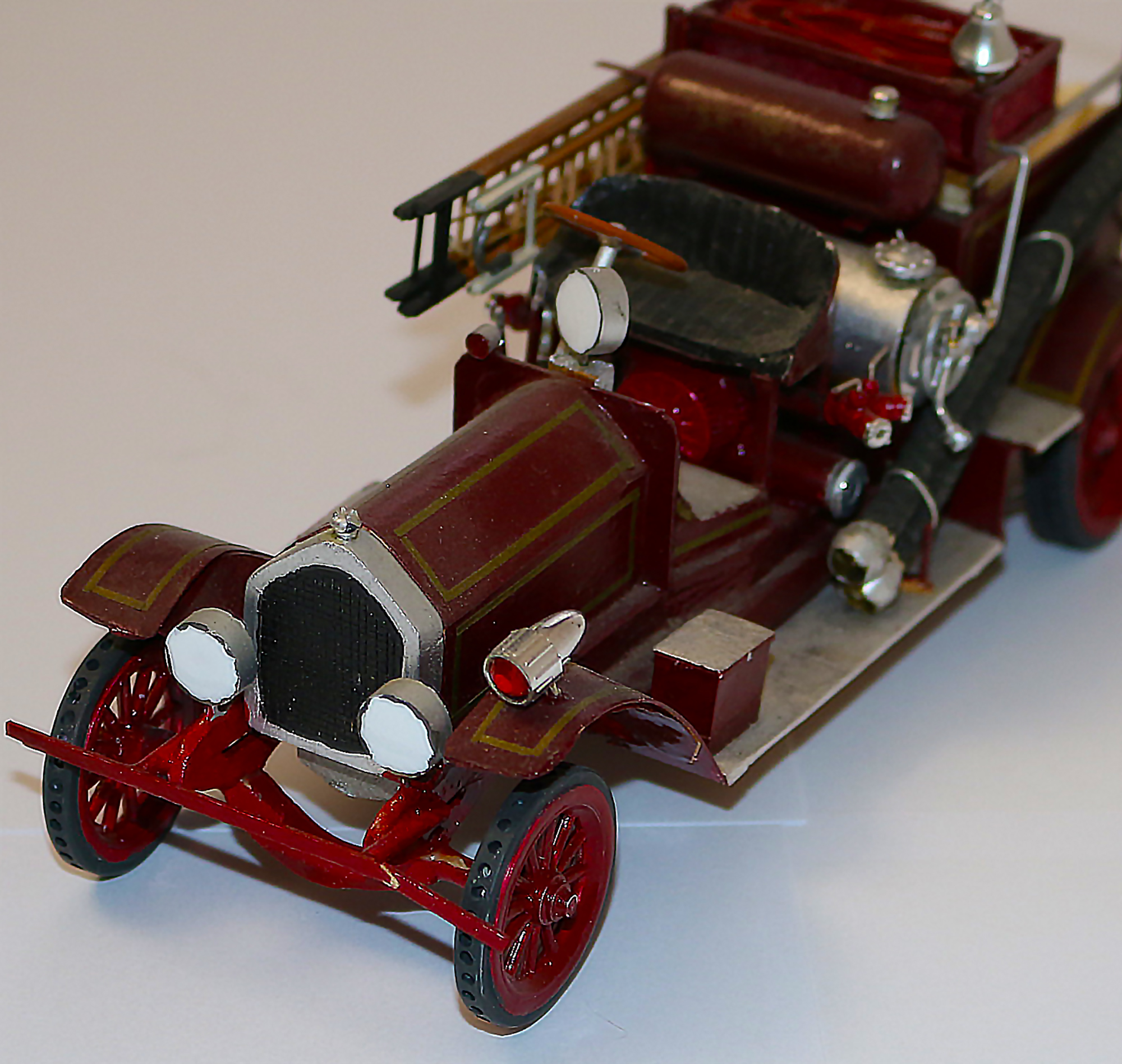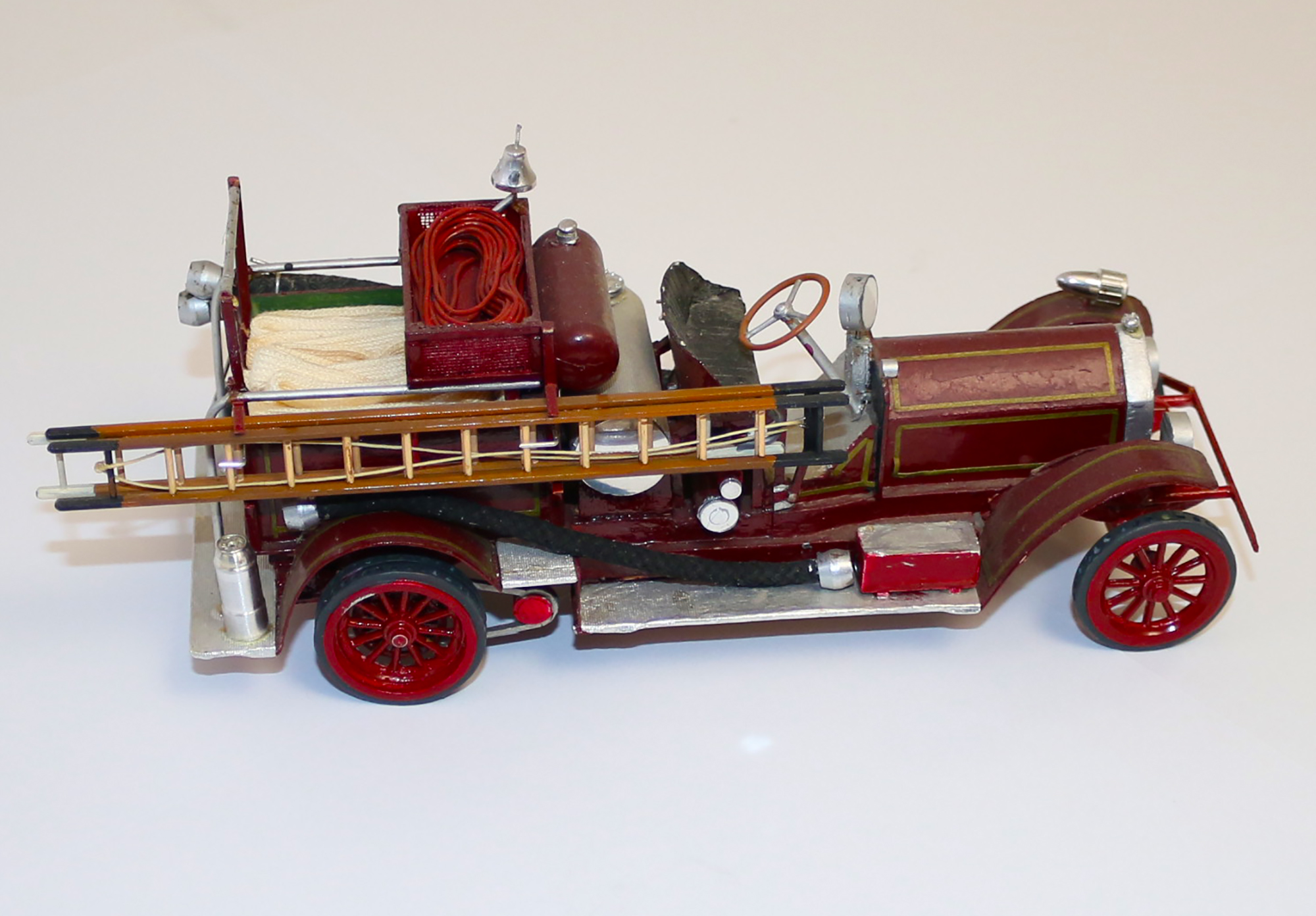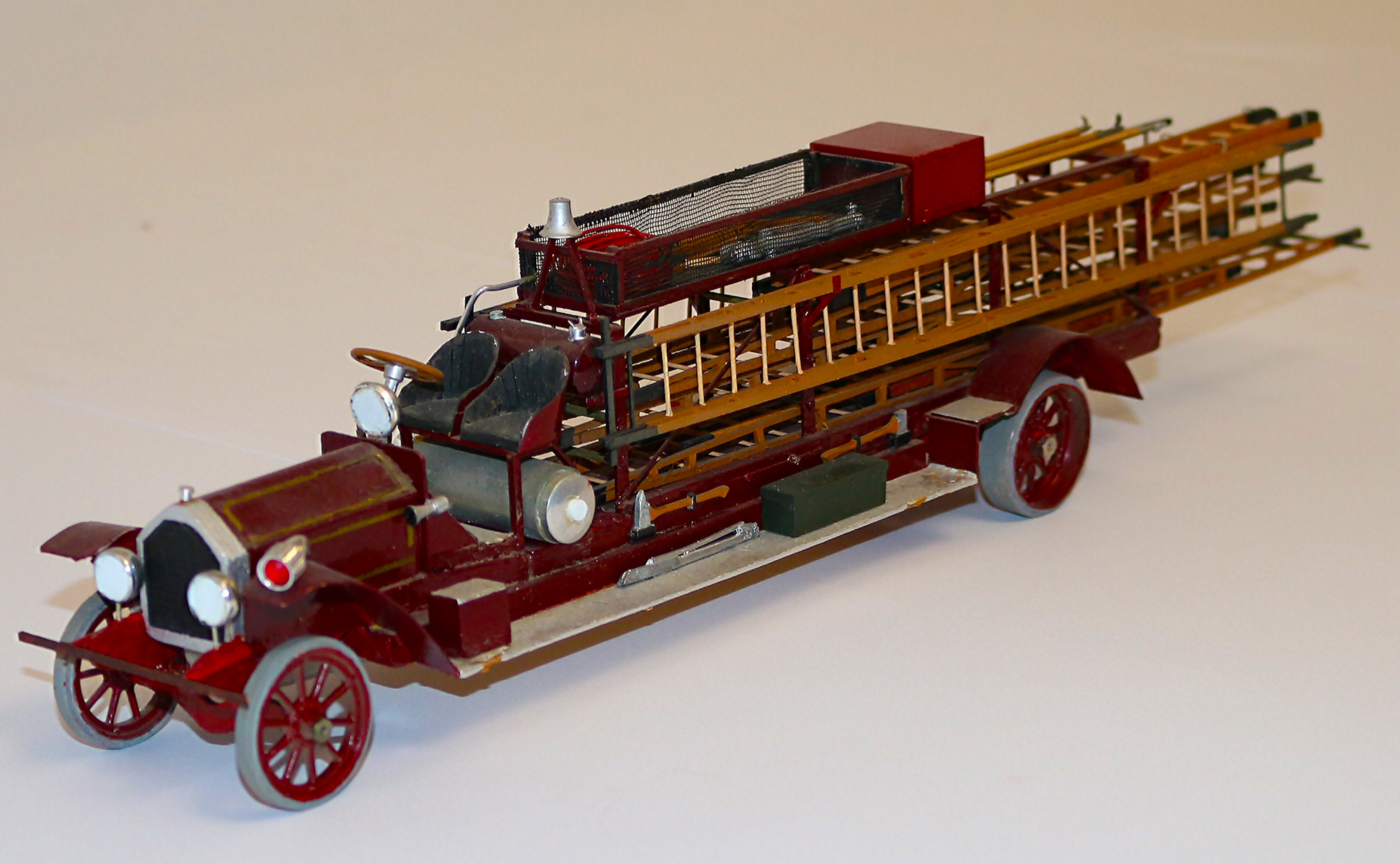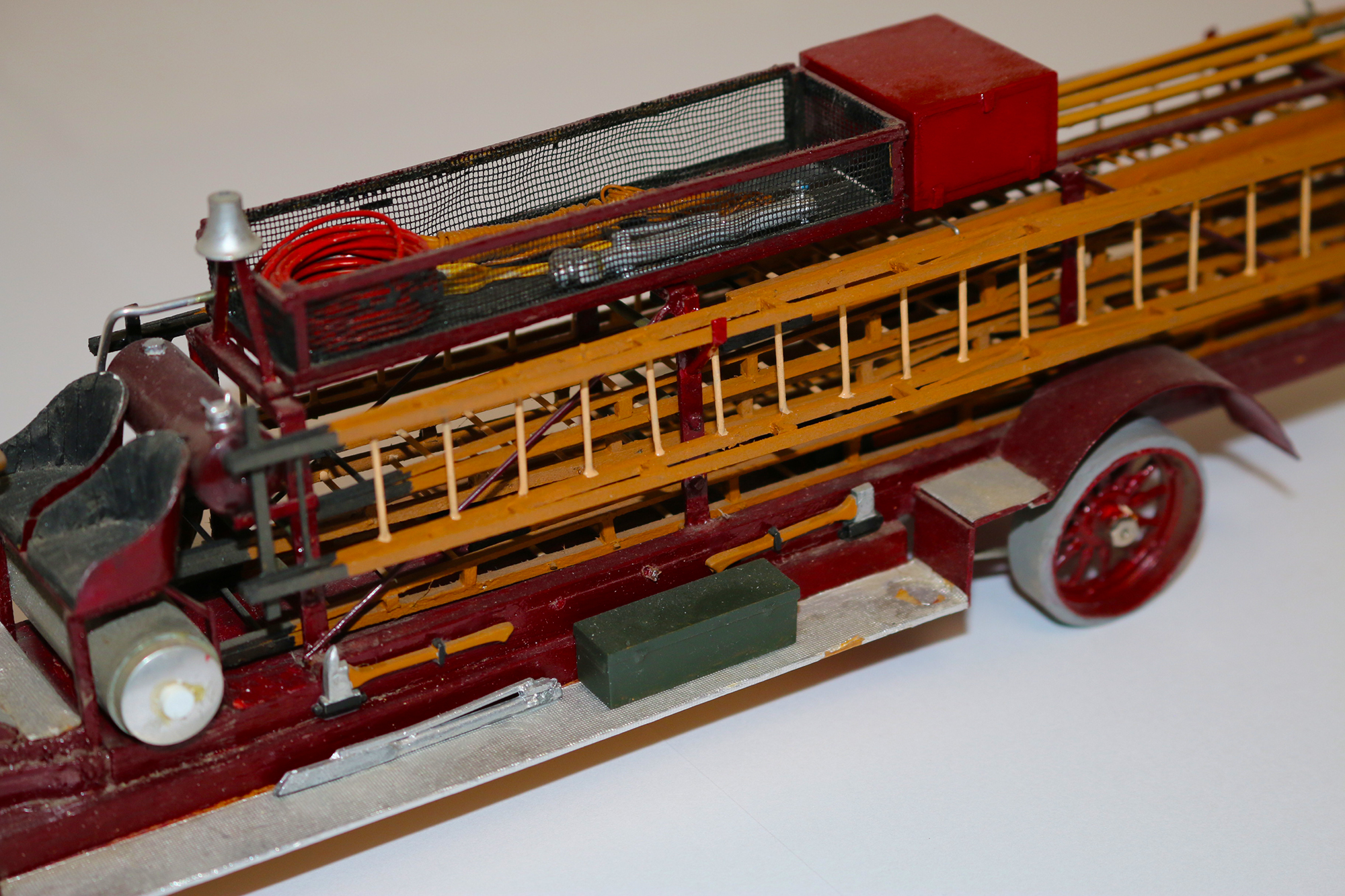Scale Replica Fire Apparatus Model Maker
John Ackerman, then and now.
Introduction
John Ackerman, a US Army veteran and former volunteer firefighter, is also a renowned model maker. In particular, John creates scale replicas of fire stations and various fire apparatus. He has written several how-to magazine articles on the topic, and has also presented demonstrations on the complicated process of scratch-building models. John’s work has been displayed at several model shows, libraries, museums, and art galleries. This includes an ongoing display at the Los Angeles Fire Department Historical Society Fire Museum, at Old Fire Station 27 in Hollywood, CA.
Additionally, John is also a director on the board for The Mini Time Machine Museum of Miniatures in Tucson, AZ. He is a founder and lifetime member of the Los Angeles Fire Department Historical Society (LAFDHS) where he served as chair of various committees. John is also a former member of the Board of Directors for LAFDHS, and was instrumental in their effort to turn Old Fire Station 27 into the Los Angeles Fire Department Museum and Memorial. As a member-at-large, he continues to be an LAFD apparatus historian, and he also co-administers the LAFD Historical Society Facebook group. John is actively retired in Green Valley, AZ. However, he continues to make and restore scale replica fire apparatus models for public and private collections. He also owns a technical publishing company.
Mr. Ackerman is the volunteer caretaker of the Tom Showers miniature scale fire apparatus collection—some of which is on display at the Miniature Engineering Craftsmanship Museum. In that role, John works on the restoration of Tom’s miniature apparatus and fire stations. However, he also helps to maintain a display at the LAFDHS Museum, as well as assisting with another at the Los Angeles County Fire Museum. John has been building and collecting miniature fire apparatus since he was 6 years old. His grandfather was a New York City fireman (FDNY 1922-1941), and his great-grandfather was a founder of his own hometown’s volunteer fire department. John’s father, Altho, didn’t necessarily follow in those footsteps. However, he catered to John’s passion by taking him on visits to different fire departments in their hometown as well as New Jersey and New York City.
John’s family moved to Los Angeles when he was 11. His very first model survived that and subsequent moves. The two pictures above show how the model and its firefighting figures look today.
Through the Years…
At only 6 years old, John had already developed a love for firefighting that would be the driving force behind his model making. He had decided that the die-cast model fire truck that he owned needed some firefighters. Unfortunately, all he had were miniature army soldiers. So John set about repurposing the soldiers (sculpting rifles into fire nozzles and adding new paint), before soon realizing that they weren’t the correct scale for his model. So, with his dad’s help and encouragement, John decided to make a new fire truck that would better suit his crew.
Luckily, John’s father had dabbled in making model airplanes. He suggested that the two of them could make a miniature fire engine closer to the scale of his firefighters together. They primarily used cardboard and other random goods from around the house as material. Since the model was also going to function as a toy, it was imperative that it be engineered well enough to hold up for its miniature duties. Of course, a workable hose was required, so modeling clay was rolled into varying lengths and sizes to address that need.
Because the die-cast model was nearly identical to one of the actual engines at the local volunteer fire company, it was kept as an integral part of John’s collection. When John was in high school during the early 1960’s, most people were making model kit hot rods and customizing them. John thought it would be fun to try his hand at some scratch-building using Balsa wood. These turned out better than his first model engine, but they lacked the precision that he was seeking.
It was in 1964 that John learned of a local fire apparatus model maker named Phil Da Costa, who also worked from scratch. Fortunately, John was able to meet up with Phil, who would soon become his first mentor. With Phil’s assistance, John was able to make his first scale piece of fire apparatus—a water tower—in his senior year of high school. Phil was instrumental in teaching John how to work with basswood, Bristol Board, and Strathmore artist paper.
While serving in the US Army in 1967 at Sandia Base, NM, John made this more detailed 1916 Chemical Car.
Finding Mentors
In 1965 (John’s senior year of high school), a model magazine published an in-depth article on the work of Tom Showers. Tom also lived in California, so John tried reaching out to him. The two corresponded by mail until they were finally able to meet up at Tom’s home in 1966—where John could admire his amazing collection. That marked the beginning of a great friendship that would continue until Tom’s passing in 1996.
Interestingly, some of John’s early fire models depicted mythical volunteer fire departments. Following his water tower project, John’s next venture would be to create a mythical fire department for Sandy Hook, New Jersey (not Sandy Hook National Park). So in 1966, John began creating a model station that included all the fire apparatus that would be necessary if Sandy Hook was a real town.
While serving for the US Army from 1966-69, John had to find downtime to make new models between work and travel. As he was attending training courses at Sandia Base in Albuquerque, New Mexico, John took the opportunity to measure and document an aerial ladder truck that served the city back in 1922. Wherever John was, he would frequently make efforts to research and learn more about local fire equipment and its respective history.
Later on, at his first duty station in Edison, New Jersey, John was able to visit several museums and fire departments. He also got to meet a few fire memorabilia collectors in that time, which helped in broadening his knowledge of fire apparatus history even more. After concluding his military service in Heilbronn, Germany, John and his wife settled down in New Jersey. There John would set up a more permanent workspace in the living room of their apartment.
Eventually, in the early 1980’s, a few fire modelers working in 1:32 scale decided to start a project developing individual mythical fire departments within a fabricated county. Tom Showers led the way building his Luna Beach fire department, and John followed with his own Los Cincos fire department. For the Los Cincos model, John made four stations and the subsequent apparatus for each one. The respective mythical cities were based on real-life target hazards, and the apparatus (which were modeled after real equipment) reflected what might actually be required for each specific area. The Los Cincos fire stations and apparatus are currently on display at the Phenix Technology facility in Riverside, CA.
The Modeling Process
Now, part of the modeling process is doing the necessary research beforehand for any object or structure that you want to replicate. Once a modeler has gotten a strong grasp of what they are copying, they can then begin the journey of actually engineering its construction. However, obtaining enough information to make a replica as accurate and culturally correct as possible can be quite challenging. Oftentimes, plans and/or an actual physical object are no longer available. In that case, a modeler’s best bet might be to find as many photos as possible, and to then literally deduce the measurements to the best of their judgement.
For John, research efforts included visiting fire departments, visiting fire and non-fire specific museums, and meeting a wide range of people with varying topical knowledge. Perhaps John’s most significant replica is that of the New York City Fire Department’s (FDNY) 1965 Super Pumper. The entire replica was made from scratch in 1:16 scale.
Being of a larger scale, whatever could be seen in photograph needed to be recreated in miniature. In looking for direction, John tried using the body layout plans for the large Napier-Deltic locomotive engine that drove the high capacity De Laval pump. However, those plans were lacking in some of the specific information that John really needed. The process of gathering information for older apparatus could be very difficult at times.
Fortunately for John, one of the last firefighters/engineers to operate the Super Pumper was able to provide him with the pump plans. Seeking even more information, John had a friend in England check with the Napier-Deltic historical society for any other documents, however this was to no avail. Then, on a visit to the Miniature Engineering Crafstmanship Museum, John happened to meet a fellow craftsman who had made a working model of the engine before. When John asked about plans, he simply laughed and replied, “You get to back into making it with the outline of your plans and many photographs.”
Throughout this process it was necessary for John to create his own tooling and fixtures along the way. At times those were separate projects all to themselves. For the super pumper project, John used brass, aluminum, and both sheet and block Styrene plastic for materials. He made a mold for the wheels from scratch, and the tires came from an old Doepke toy crane (one of John’s toys from the late 1950’s).
Somehow, John knew he needed to save the tires, but had pitched the body years before. From these the wheels and tires were cast. The Super Pumper decals were professionally printed from John’s specifications. Finally, after over 4 years of working on the project, the Super Pumper was completed. The model is currently in a private museum in Manhattan, New York.
Expanding His Toolset
Over the years, John had the privilege of meeting and working with many mentors and peers. These relationships allowed John to continually improve, and to enjoy a rewarding life of modeling. Along with his father, Phil Da Costa, and Tom Showers, John was able to learn from modelers of many different specialties. By taking the time to appreciate other miniature work, he was able to get a more well-rounded understanding of modeling as a whole. He was always grateful when other modelers would share their unique approaches and perspectives.
After engaging with a wide variety of modelers, John also realized that it would be in his best interest to learn basic machinist skills. He felt that it was important to be able to operate a lathe and milling machine for improved accuracy in his work. John steadily became proficient at operating these machines, but always considered himself a hobbyist first and foremost. Each added skill was just another instrument he could utilize to perfect his craft.
Learning how to work with brass and associated tooling was a major advancement to his skill set. John’s ability to create his own tooling was crucial for making many of the detailed parts for his models. Learning how to design and build dedicated tooling and fixtures was a fascinating venture that required innovative thinking. All of these processes were essential to engineering each project, and preserving their integrity over time.
Along with machining, John had also learned the basics of soldering as a young boy. This paid dividends later on when constructing his scale fire stations (especially for adding lighting). Working with brass and soldering tools allowed John to achieve a very distinct sense of realism in his work. Realizing this, John would go on to purchase a resistance soldering machine and a small torch to bolster his toolset.
For John, an important aspect of model making was the understanding that a replica needed to be both historically and culturally accurate. It wasn’t just about getting the measurements right. He noted that when Tom Showers created different fire apparatus (both domestic and foreign), he would also include the relevant tools and equipment to capture the cultural details associated with that time and place. Any given apparatus needed to be as historically accurate as possible if it was going to be a true representation in miniature.
Continuing to expand his expertise, John joined the International Association of Automotive Modelers (IAAM) in the early 1970’s. The group was dedicated to making authetic automotive miniatures, as well as understanding the history of the vehicles and the companies behind them. John quickly noticed that IAAM members tended to be proficient with lathes, mills, and artistic skills like airbrushing. With their encouragement and assistance, John also began using an airbrush on his models.
1914 American LaFrance City Service Ladder Truck. Built in 1966, this was John’s first attempt at making wooden ladders using plans and techniques from Phil Da Costa.
A Labor of Love
Along with his expert peers, John’s family and close friends always supported his passion for modeling. In fact, for their first Christmas as a married couple in 1967, John’s wife bought him a Unimat lathe with some money she had borrowed from her parents and set aside (at the time John was a PFC in the US Army). She was wise enough to understood that it would likely be cheaper over time for John to make his own parts, rather than constantly paying someone else to make them. She was right, and John still had the Unimat at the time of this writing.
Throughout his life John’s support group has helped him tremendously. His family and friends have supported him through the high and low points. They’ve done everything from helping him set up models at fire stations, assisting in measuring and documenting real fire trucks, helping find new modeling materials, taking vacations that doubled as research outings, and archiving the collections of historical artifacts that he gathered. John always appreciated the support and encouragement in following his passion for building exceptional scale models.
For John, model making provides a productive use of time, and a brief escape from the real world. He is quick to encourage others to explore and become proficient in a hobby that can be done individually—and not to wait until they retire!


